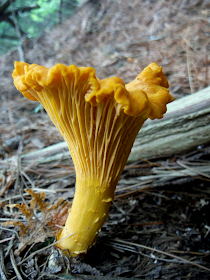I love mushrooms. Whether they are growing on the forest floor or sauteed in garlic on my dinner plate, I am a fan of the fungal fruiting body. So it's only natural that once we found ourselves living a life amongst the trees that we would give mushroom foraging a try.
Disclaimer #1: Do not use any of the information in this post for the purpose of identification and never eat any wild mushrooms without the 100% identification of an expert. Be careful, be respectful, and if in doubt, don't eat or pick it.
We decided to start out with a simple mushroom foraging goal: find our own Chanterelles, a mushroom from a complex and wide family with several edible varieties.
Chanterelles are most distinctively identified by their "false gills", which more resemble wrinkles than the gills most of us imagine when we think of traditional mushrooms. Chanterelles are sometimes vase, trumpet, or horn shaped and vary in color and ecology, and like most mycological curiosities, sit on the blurry lines of taxonomy.
Since I have a knack for keeping my nose to the ground and snuffling out the otherwise overlooked treasures of the mottled forest floor, we found several varieties of Chanterelles during this first year as newbie foragers, with tasty and passionate results. Almost every meal of wild mushrooms was ended with discussion on when and where we were going to find more.
When you mention the edible Chanterelle, the species of note is usually Cantharellus cibarius (lead photo & above) This is what you will most often find on your dinner plate when ordering seasonal wild mushrooms. It is a forager's delight - shining brightly like citrine gems amongst the hardwood forest leaf litter. It's hard to mistake the fleshy mushroom and it's sweet smelling apricot aroma once spotted from afar.
My favorite variety of Chanterelle is the Yellow Foot, Craterellus tubaeformis, and it's closely related ally, Craterellus aurora. I love them in their abundance, almost always frequenting the same mossy stream sides as I am. Their happy yellow stipes remind me that there is edible wonder afoot, sometimes inspiring me to pick dinner and other times just invoking that wonderful feeling of a positive identification.
I probably love them because I am so spoiled to have these fleshy beings throughout my local forest, including a tender patch just down on our riverside that I have anxiously watched grow from their young "button" form into the mature, edible form.
(It is sometimes a bit heavy to think about these secretive bodies, flushing so quietly under the protective canopy, just a stone's throw away from where we search)
But for me, the holy grail of Chanterelle hunting is Craterellus cornucopioide, the Horn of Plenty or Black Chanterelle. And lordy, are these ever hard to find. If not for my hawkish eyes, we would have walked right past these masters of camouflage (heck, we probably even did many times before), for in their purply-blackish design blend perfectly into the leaf litter. Decidedly different looking from its yellow footed and more famously available cousins, the Black Chanterelle wears its fruit in a velvety thin horn and is easily identified by its strong, sweet smell.
We cooked only a small amount of these babies up with a Yellow Foot harvest from the same day and unanimously decided they were not only the best variety we had ever tasted, but that the delightful aroma was absorbed into the rest of the more mild tasting mushrooms. Total culinary score, especially considering how hard they are to find.
Alas, Chanterelle hunting season here in Vermont is coming to an end. Soon winter will be upon us and we will return to our foraging books and field guides with our eyes towards spring and the bounties of a fresh season. So I'll leave you with my favorite picture of Phyllis wearing a Cantharellus cibarius as a hat and looking dashing:
You can read other posts where I gush over mushrooms and mushroom hunting here:
And finally, just to cover my ass, Disclaimer #2: Tread lightly in nature. When foraging, take less than 5% of the total patch, leaving the rest to their natural obligations. Understand that allergies and other food sensitivities make trying wild edibles the consumer's risk. Do not use this post as reference or in identification.
Many
plants are poisonous some are deadly poisonous. In the end, the
responsibility for eating any plant must rest with the individual; for
instance there are people who are allergic to certain wild edible
plants. - See more at:
http://www.foragingcourses.com/disclaimer#sthash.hPPu4FbI.dpuf














No comments:
Post a Comment